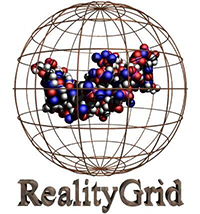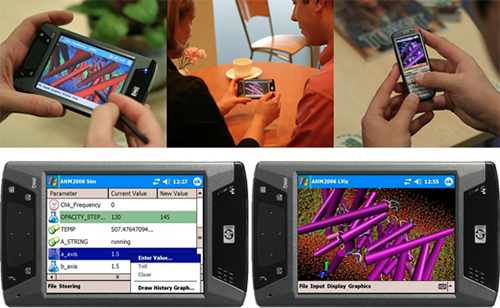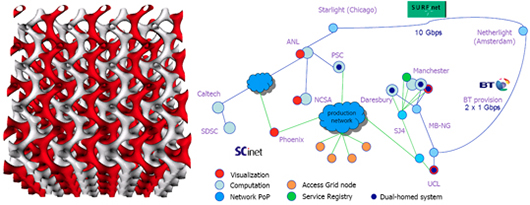Engineering and Manufacturing
EPSRC e-Science Reality Grid

RealityGrid: moving the bottleneck out of the hardware and back into the human mind
Our definition of grid computing is "distributed computing performed transparently across multiple administrative domains". This refers to an ambitious and exciting global effort to develop an environment in which individual users can access computers, databases and experimental facilities simply and transparently, without having to consider where those facilities are located. Using grid technology to closely couple high throughput experimentation and visualisation, RealityGrid has led the way in showing how close we are to realising this new computing paradigm today.
A twin-track approach has been employed within RealityGrid: a "fast track" used currently available grid middleware to construct a working grid, while a "deep track" involved computer science teams in harnessing leading-edge research to create a robust and flexible problem-solving environment in which to embed the RealityGrid.
RealityGrid has thus provided a highly flexible and robust computing infrastructure for supporting the modelling of complex condensed matter systems, including life science. The opportunity to exploit exceptionally vast high performance computing resources linked via grid infrastructure, coupled to novel methodological paradigms through steering and visualisation together with use of scalable algorithms, has led to important scientific results, which would otherwise not have been possible within the project's lifetime.
Useful information on grid computing can be found on The Global Grid Forum. The UK Grid Support Centre provides support for UK grid applications.
Sub-project - SuperComputing in the Palm of Your Hand

Scope
Scientists need to be able to be able to monitor and interact with simulations that require lengthy periods of computation on the Grid (48hrs would be a typical example). Being tied to a computer workstation for prolonged periods is a considerable disadvantage, so a solution that allows the scientist to interact with their Grid-based simulations whilst being away from the desk environment is highly desirable.
Objectives
Research conducted by the AVRRC developed an effective lightweight user interfaces for e-Science. Scientists are able to interact in real-time with simulations and visualisations running on the Grid (a process known as computational steering). The default user interface for this type of activity is a specialised computer workstation with high-end 3D graphics capabilities. The research challenge was to engineer a lightweight client that can efficiently deliver the required level of user interaction through affordable, commodity user interface hardware. This will allow the scientist to access and interact with their applications on the Grid from anywhere at anytime.
Research Output
This research project has produced the RealityGrid PDA Client: a lightweight user interface that efficiently enables the scientist to execute their application workflows, computationally steer their simulations and explore their complex 3D visualisations, all in real-time via a handheld PDA or Smartphone device .
Publications
Kalawsky, R.S. and S.P. Nee, e-Science RealityGrid - Human Factors Audit Requirements and Context Analysis, 2004, Loughborough University.
Kalawsky, R.S., et al., A grid-enabled lightweight computational steering client: a .NET PDA implementation. Philosophical Transactions of the Royal Society a-Mathematical Physical and Engineering Sciences, 2005. 363(1833): p. 1885-1894.
Kalawsky, R.S., J. O'Brien, and P.V. Coveney, Improving scientists' interaction with complex computational-visualization environments based on a distributed grid infrastructure. Philosophical Transactions of the Royal Society a-Mathematical Physical and Engineering Sciences, 2005. 363(1833): p. 1867-1884.
Nee, S.P. and R.S. Kalawsky. Developing a Roaming PDA-Based Interface for a Steering Client for OGSI::Lite using .Net: Practical Lessons Learned. in EPSRC e-Science All Hands Meeting. 2004. Nottingham.
O'Brien J. T. and Kalawsky R. S. A novel control mechanism for distributed stream rendering. in Theory and Practice of Computer Graphics (TPCG'07). 2007. Bangor, Wales, UK: Eurographics Association.
O’Brien, J.T. and R.S. Kalawsky. A Service Agreement Framework for Grid based Distributed Rendering. in EPSRC e-Science All Hands Meeting. 2007.
Sub-project - TeraGyroid: Grid-based lattice-Boltzmann simulations of defect dynamics in amphiphilic liquid crystals

Awards
The recorded video stream of the TeraGyroid presentation can be viewed here (Windows Media Player ASF stream). The information flyer distributed at SC03 can be found here.
TeraGyroid also received a 2004 ISC (International Supercomputer Conference) award, the major supercomputing award in Europe, for Integrated Data and Information Management.
Partners
RealityGrid was a collaboration between distinguished teams of physical scientists, computer scientists and software engineers.
The collaborating universities, each of which is already exceptionally well resourced, comprise:
- University College, London (Centre for Computational Science and Department of Chemistry)
- University of Edinburgh (Department of Physics and Astronomy and Edinburgh Parallel Computing Centre)
- University of Manchester (Manchester Computing and Department of Computer Science)
- Imperial College, University of London (Department of Computing)
- Loughborough University (Loughborough University Advanced VR Research Centre and Department of Mathematical Sciences)
- University of Oxford (Department of Materials).
Five of these universities became UK e-Science Centres:
- National e-Science Centre (University of Edinburgh)
- London e-Science Centre (University of London)
- e-Science North West (University of Manchester)
- Oxford e-Science Centre (University of Oxford)
- East Midlands e-Science Centre (Loughborough University)
The collaborating organisations included the
- Computation for Science Consortium (which operates the UK's national supercomputing facility CSAR in Manchester)
- Schlumberger Cambridge Research Ltd.
- Edward Jenner Institute for Vaccine Research
- Silicon Graphics Inc.
- Advanced Visual Systems Inc.
- Fujitsu Ltd.
- BTexact (in collaboration with University of Manchester)
The project also had a strong international dimension, involving collaborations with several US Universities and National Laboratories as well as with the US-TeraGrid and European supercomputing centres. There was an International Advisory Board to ensure the project achieved against world class standards.
